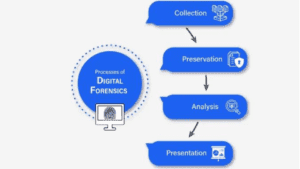Cyber crime is on the rise and affecting individuals, businesses and even governments. As cyber criminals get more sophisticated, law enforcement agencies rely on digital forensics to track down criminals, gather evidence and bring them to justice. Digital forensics involves the collection, preservation, analysis and presentation of data from electronic devices to support investigations.
In this article, we’ll explore the key role digital forensics plays in cyber crime Investigations, how it works and why it’s crucial in today’s digital world.
1. What is Digital Forensics?
Digital forensics is the process of retrieving, analyzing and preserving data from digital devices in a way that’s legally acceptable. This data can come from computers, smartphones, servers, network logs, emails and even social media accounts. Investigators use this data to trace criminal activities, uncover motives and build cases against cybercriminals.
Digital forensics goes beyond just finding deleted files. It also involves recovering hidden data, decrypting information and identifying patterns in communication or internet activity that can point to criminal behavior.
2. Why is Digital Forensics Essential in Cyber crime Investigations?
A. Recovering Deleted or Hidden Data
Cybercriminals often try to cover their tracks by deleting files, wiping hard drives, or using encryption. Digital forensic experts can recover this deleted data and access hidden or encrypted files using specialized tools. This evidence can be crucial in identifying the criminal and understanding how the crime was committed.
For example, in a hacking case, forensic experts can recover logs or communications between the hacker and their target, which might have been deleted intentionally.
B. Tracing the Source of an Attack
One of the biggest challenges in cyber crime investigations is identifying the person behind the attack. Hackers often use methods like VPNs, proxies and encryption to hide their identities. However, forensic analysts can trace the source of the attack by analyzing network traffic, IP addresses and logs.
Digital forensics experts can also examine malicious software to understand its origin and the techniques used. This helps them link the crime to a specific group or individual.
C. Preserving Evidence
One key role of digital forensics is preserving the integrity of the evidence. Cyber crime investigators need to ensure that the data they collect is not tampered with and can hold up in court. This involves creating exact copies (images) of the data so that the original can remain untouched.
These images are used to run tests and analysis without affecting the actual evidence. By following strict guidelines, digital forensic experts make sure that the evidence is legally sound and admissible in court.
D. Building a Timeline
To understand how a cyber crime unfolded, investigators often need to build a timeline of events. Digital forensics plays a big part in this process. Forensic experts can piece together activities by analyzing logs, timestamps on files and browser history.
For instance, in a ransomware attack, the expert might track when the malware was installed, when the attacker first accessed the system and how long the hacker stayed inside before encrypting the data.
E. Identifying Connections Between Multiple Crimes
Digital forensic analysis can also help investigators link separate cyber crimes. By examining similarities in methods, tools and software used in different attacks, investigators can identify patterns. This helps them understand whether a single criminal or group is responsible for multiple attacks.
For example, forensic analysis might reveal that several ransomware attacks were carried out using the same type of malware, linking them to a specific cyber crime syndicate.

3. Common Types of Cyber crimes Investigated Using Digital Forensics
A. Hacking and Data Breaches
In cases of hacking, forensic investigators look at how the intruder gained access to the system, what data was stolen or altered and whether any backdoors were left open for future attacks. They analyze log files, network traffic and malware to understand the scope of the breach and how to prevent it from happening again.
B. Financial Fraud and Identity Theft
Cybercriminals often steal sensitive information like credit card details, bank account numbers and social security numbers to commit financial fraud or identity theft. Digital forensics can trace how this information was obtained, whether it was through phishing emails, malware, or unauthorized access to systems. The forensic team can then track where this data was sent and how it was used.
C. Child Exploitation and Online Abuse
Forensic investigators play a critical role in solving cases involving child exploitation and online abuse. They recover hidden or deleted content from devices, trace communication between the criminals and their victims and analyze patterns in online activity. This evidence is crucial in identifying the criminals and bringing them to justice.
D. Cyberterrorism
Cyberterrorism involves using technology to cause harm or create fear, often by attacking critical infrastructure like power grids or financial systems. Digital forensics helps identify the individuals or groups responsible by analyzing their tools, methods and communications.
Also Read: How Digital Forensics Can Decrypt WhatsApp Messages
4. Tools Used in Digital Forensics
To carry out investigations, digital forensic experts use a range of specialized tools. These tools help them recover, analyze and present data in a way that is clear and understandable.
Some common tools include:
- EnCase: A powerful tool used for analyzing computers and mobile devices. It helps investigators recover deleted files, emails and other important data.
- FTK (Forensic Toolkit): FTK assists with scanning hard drives and other storage devices to recover hidden or encrypted files. It is known for creating detailed reports that can be used in court.
- XRY: A tool designed specifically for mobile forensics, allowing experts to extract data from smartphones, including call logs, messages and app data.
- Wireshark: This tool helps analyze network traffic. Forensic experts use it to track data packets and identify malicious activity on a network.
5. Challenges in Digital Forensics
While digital forensics plays a vital role in cyber crime investigations, it comes with its own set of challenges.
A. Encryption and Privacy
Many cybercriminals use encryption to hide their tracks. While encryption is a legitimate tool for protecting privacy, it also poses a challenge for forensic experts trying to access crucial data. Investigators need to balance the need for security with privacy concerns when handling encrypted information.
B. Constantly Evolving Technology
Technology is constantly changing, with new devices, software and methods emerging all the time. Cybercriminals are quick to adapt to these changes, using the latest tools to commit crimes. Forensic experts must keep up with these developments to stay effective.
C. Data Overload
In some cases, investigators are faced with vast amounts of data to analyze. Sorting through this data to find relevant information can be time-consuming and requires advanced tools and techniques.
Conclusion
Digital forensics plays a key role in solving cyber crime cases. From recovering deleted data to tracing the source of an attack, forensic experts provide vital evidence that helps investigators catch cybercriminals. Their work ensures that evidence is preserved, analyzed and presented in a way that can stand up in court. As cyber crimes continue to evolve, the field of digital forensics will remain essential in ensuring justice is served.




